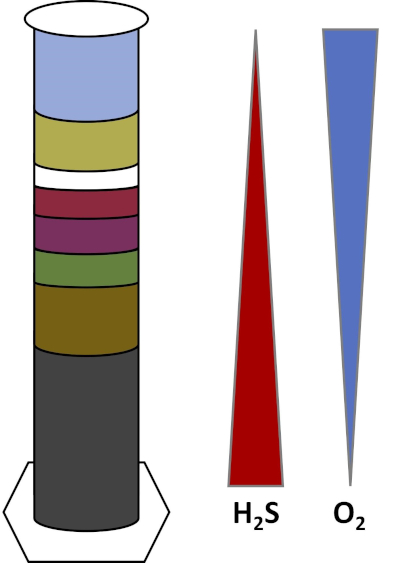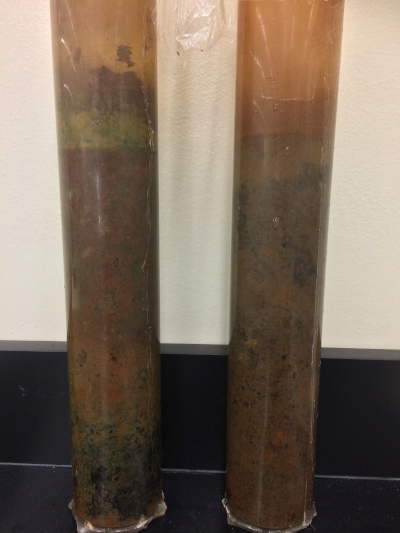Creazione di una colonna di Winogradsky: un metodo per arricchire le specie microbiche presenti in un campione di sedimento
Panoramica
Fonte: Elizabeth Suter1, Christopher Corbo1, Jonathan Blaize1
1 Dipartimento di Scienze Biologiche, Wagner College, 1 Campus Road, Staten Island NY, 10301
La colonna Winogradsky è un ecosistema in miniatura e chiuso utilizzato per arricchire le comunità microbiche dei sedimenti, in particolare quelle coinvolte nel ciclo dello zolfo. La colonna fu utilizzata per la prima volta da Sergei Winogradsky nel 1880 e da allora è stata applicata nello studio di molti microrganismi diversi coinvolti nella biogeochimica, come fotosintetizzatori, ossidanti dello zolfo, riduttori di solfato, metanogeni, ossidanti del ferro, ciclori di azoto e altro (1,2).
La maggior parte dei microrganismi sulla Terra sono considerati incoltibili, il che significa che non possono essere isolati in una provetta o su una capsula di Petri (3). Ciò è dovuto a molti fattori, tra cui il fatto che i microrganismi dipendono da altri per determinati prodotti metabolici. Le condizioni in una colonna di Winogradsky imitano da vicino l'habitat naturale di un microrganismo, comprese le loro interazioni con altri organismi, e consentono di farli crescere in laboratorio. Pertanto, questa tecnica consente agli scienziati di studiare questi organismi e capire quanto siano importanti per i cicli biogeochimici della Terra senza doverli coltivare in isolamento.
Gli ambienti della Terra sono pieni di microrganismi che prosperano in tutti i tipi di habitat,come suoli, acqua oceanica, nuvole e sedimenti di acque profonde. In tutti gli habitat, i microrganismi dipendono l'uno dall'altro. Man mano che un microrganismo cresce, consuma particolari substrati,inclusi combustibili ricchi di carbonio come zuccheri e sostanze nutritive, vitamine e gas respiratori come l'ossigeno. Quando queste importanti risorse si esauriscono, diversi microrganismi con diverse esigenze metaboliche possono quindi fiorire e prosperare. Ad esempio, nella colonna Winogradsky, i microbi consumano prima il materiale organico aggiunto mentre esauriscono l'ossigeno negli strati inferiori della colonna. Una volta esaurito l'ossigeno, gli organismi anaerobici possono quindi prendere il sopravvento e consumare diversi materiali organici. Questo sviluppo consecutivo di diverse comunità microbiche nel tempo è chiamato successione (4). La successione microbica è importante in una colonna di Winogradsky, dove l'attività microbica cambia la chimica del sedimento, che quindi influenza l'attività di altri microbi e così via. Molti microrganismi nei suoli e nei sedimenti vivono anche lungo gradienti, che sono zone di transizione tra due diversi tipi di habitat in base alle concentrazioni di substrati (5). Nel punto corretto del gradiente, un microbo può ricevere quantità ottimali di diversi substrati. Man mano che una colonna winogradsky si sviluppa, inizia a imitare questi gradienti naturali, in particolare nell'ossigeno e nel solfuro (Fig. 1).

Figura 1: Rappresentazione dei gradienti di ossigeno (O2) e solfuro (H2S) che si sviluppano in una colonna di Winogradsky.
In una colonna Winogradsky, il fango e l'acqua di uno stagno o di una zona umida sono mescolati in una colonna trasparente e lasciati incubare, in genere alla luce. Ulteriori substrati vengono aggiunti alla colonna per fornire alla comunità fonti di carbonio, di solito sotto forma di cellulosa e zolfo. I fotosintetizzatori in genere iniziano a crescere negli strati superiori del sedimento. Questi microrganismi fotosintetici sono in gran parte composti da cianobatteri, che producono ossigeno e appaiono come uno strato verde o rosso-marrone (Fig. 2, Tabella 1). Mentre la fotosintesi produce ossigeno, l'ossigeno non è molto solubile in acqua e diminuisce al di sotto di questo strato (Fig. 1). Questo crea un gradiente di ossigeno, che va da alte concentrazioni di ossigeno negli strati superiori a zero ossigeno negli strati inferiori. Lo strato ossigenato è chiamato strato aerobico e lo strato senza ossigeno è chiamato strato anaerobico.
Nello strato anaerobico, molte diverse comunità microbiche possono proliferare a seconda del tipo e della quantità di substrati disponibili, della fonte dei microbi iniziali e della porosità del sedimento. Nella parte inferiore della colonna, gli organismi che anaerobamente abbattono la materia organica possono prosperare. La fermentazione microbica produce acidi organici dalla scomposizione della cellulosa. Questi acidi organici possono quindi essere utilizzati dai riduttori di solfato, che ossidano quelle sostanze organiche usando il solfato e producono solfuro come sottoprodotto. L'attività dei riduttori di solfato è indicata se il sedimento diventa nero, perché ferro e solfuro reagiscono per formare minerali di solfuro di ferro nero (Fig. 2, Tabella 1). Il solfuro si diffonde anche verso l'alto, creando un altro gradiente in cui le concentrazioni di solfuro sono alte nella parte inferiore della colonna e basse nella parte superiore della colonna (Fig. 1).
Vicino al centro della colonna, gli ossidanti di zolfo sfruttano l'apporto di ossigeno dall'alto e solfuro dal basso. Con la giusta quantità di luce, gli ossidanti fotosintetici dello zolfo possono svilupparsi in questi strati. Questi organismi sono noti come batteri dello zolfo verde e viola e spesso appaiono come filamenti e macchie verdi, viola o rosso porpora (Fig. 2, Tabella 1). I batteri dello zolfo verde hanno una maggiore tolleranza per il solfuro e di solito si sviluppano nello strato direttamente sotto i batteri dello zolfo viola. Sopra i batteri dello zolfo viola, possono anche svilupparsi batteri viola non solforo. Questi organismi fotosintetizzano usando acidi organici come donatori di elettroni invece di solfuro e spesso appaiono come uno strato rosso, viola, arancione o marrone. Gli ossidanti di zolfo non fotosintetici possono svilupparsi sopra i batteri viola non solforati, e questi di solito appaiono come filamenti bianchi (Fig. 2, Tabella 1). Inoltre, le bolle possono anche formarsi nella colonna Winogradsky. Le bolle negli strati aerobici indicano la produzione di ossigeno da parte dei cianobatteri. Le bolle negli strati anaerobici sono probabilmente dovute all'attività dei metanogeni,organismi che anaerobicamente abbattono la materia organica e formano il metano come sottoprodotto.
| Posizione nella colonna | Gruppo funzionale | Esempi di organismi | Indicatore visivo |
| In alto | Fotosintetizzatori | Cianobatteri | Strato verde o bruno-rossastro. A volte bolle di ossigeno. |
| Ossidanti dello zolfo non fotosintetici | Beggiatoa, Thiobacilus | Strato bianco. | |
| Batteri viola nonsolforo | Rhodomicrobium, Rhodospirilum, Rhodopseuodmonas | Strato rosso, viola, arancione o marrone. | |
| Batteri dello zolfo viola | Cromatio | Strato viola o rosso porpora. | |
| Batteri dello zolfo verde | Clorobio | Strato verde. | |
| Batteri che riducono il solfato | Desulfovibrio, Desulfotomaculum, Desulfobacter, Desulfuromonas | Strato nero. | |
| Fondoschiena | Metanogeni | Metanococco, Metanosarcina | A volte bolle di metano. |
Tabella 1: I principali gruppi di batteri che possono apparire in una classica colonna Winogradsky, dall'alto verso il basso. Vengono forniti esempi di organismi di ciascun gruppo e vengono elencati gli indicatori visivi di ciascuno strato di organismi. Basato su Perry et al. (2002) e Rogan et al. (2005).
Procedura
1. Configurazione
- Per impostare una colonna Winogradsky, avrai bisogno di alcune forniture di base:
- Una pala, un secchio e una bottiglia per raccogliere i campioni sul campo
- Un recipiente verticale e trasparente, come un cilindro graduato o una bottiglia d'acqua di plastica di circa 1L
- Involucro di plastica e elastici
- grandi ciotole di miscelazione e cucchiaio grande per mescolare
- Una fonte di zolfo (tuorlo d'uovo o solfato di calcio) <
Risultati
In questo esperimento, acqua e sedimenti sono stati raccolti da un habitat di acqua dolce. Due colonne Winogradsky sono state costruite e lasciate sviluppare: una classica colonna Winogradsky incubata nella luce a temperatura ambiente (Fig. 2A) e una colonna Winogradsky incubata al buio a temperatura ambiente (Fig. 2B).

Figura 2B: Una foto della classica colonna Winogradsky (a sinistra), incu
Applicazione e Riepilogo
La colonna Winogradsky è un esempio di ecosistema microbico interdipendente. Dopo aver mescolato fango, acqua e substrati aggiuntivi di carbonio e zolfo in una colonna verticale, l'ecosistema stratificato dovrebbe stabilizzarsi in zone separate e stabili per diverse settimane. Queste zone sono occupate da diversi microrganismi che prosperano in un punto particolare lungo il gradiente tra il sedimento ricco di solfuro nella parte inferiore e il sedimento ricco di ossigeno nella parte superiore. Manipolando le condizioni .
Riferimenti
- Zavarzin G. (2006). Winogradsky and modern microbiology. Microbiology 75(6): 501-511. doi: 10.1134/s0026261706050018
- Esteban DJ, Hysa B, and Bartow-McKenney C (2015). Temporal and Spatial Distribution of the Microbial Community of Winogradsky Columns. PLoS ONE 10(8): e0134588. doi:10.1371/journal.pone.0134588
- Lloyd KG, Steen AD, Ladau J, Yin J, and Crosby L. (2018). Phylogenetically novel uncultured microbial cells dominate Earth microbiomes. mSystems 3(5): e00055-18. doi:10.1128/mSystems.00055-18
- Anderson DC, and Hairston RV (1999). The Winogradsky Column & Biofilms: Models for Teaching Nutrient Cycling & Succession in an Ecosystem. The American Biology Teacher, 61(6): 453-459. doi: 10.2307/4450728
- Dang H, Klotz MG, Lovell CR and Sievert SM (2019) Editorial: The Responses of Marine Microorganisms, Communities and Ecofunctions to Environmental Gradients. Frontiers in Microbiology 10(115). doi: 10.3389/fmicb.2019.00115
- Stomp M, Huisman J, Stal LJ, and Matthijs HCP. (2007) Colorful niches of phototrophic microorganisms shaped by vibrations of the water molecule. ISME Journal. 1(4): 271-282. doi:10.1038/ismej.2007.59
- Perry JJ, Staley JT, and Lory S. (2002) Microbial Life, First Edition, published by Sinauer Associates
- Rogan B, Lemke M, Levandowsky M, and Gorrel T. (2005) Exploring the Sulfur Nutrient Cycle Using the Winogradsky Column. The American Biology Teacher, 67(6): 348-356. doi: 10.2307/4451860
Vai a...
Video da questa raccolta:

Now Playing
Creazione di una colonna di Winogradsky: un metodo per arricchire le specie microbiche presenti in un campione di sedimento
Microbiology
128.2K Visualizzazioni

Diluizioni seriali e piastratura: la conta microbica
Microbiology
313.9K Visualizzazioni

Culture di arricchimento: coltura di microbi aerobici e anaerobici su terreni selettivi e differenziali
Microbiology
131.7K Visualizzazioni

Colture pure e piastratura per striscio: isolamento di singole colonie batteriche da un campione misto
Microbiology
165.7K Visualizzazioni

Sequenziamento dell'rRNA 16S: una tecnica basata sulla PCR per identificare le specie batteriche
Microbiology
187.9K Visualizzazioni

Curve di crescita: generazione di curve di crescita utilizzando le unità formanti colonia e la misurazione della densità ottica
Microbiology
293.0K Visualizzazioni

Test di suscettibilità agli antibiotici: test dell'epsilometro per determinare i valori MIC di due antibiotici e valutare la sinergia antibiotica
Microbiology
93.4K Visualizzazioni

Microscopia e colorazioni: la colorazione di Gram, delle endospore e del capside
Microbiology
362.4K Visualizzazioni

Saggio delle placche: un metodo per determinare il titolo virale in unità formanti placca (UFP)
Microbiology
185.6K Visualizzazioni

Trasformazione di cellule di E. coli tramite l'utilizzo di una procedura basata sul metodo del cloruro di calcio
Microbiology
86.3K Visualizzazioni

Coniugazione: un metodo per trasferire la resistenza all'ampicillina dal donatore al ricevente E. coli
Microbiology
38.1K Visualizzazioni

La trasduzione batterica tramite fagi: un metodo per trasferire la resistenza all'ampicillina da una cellula donatore di E. coli ad una ricevente
Microbiology
28.9K Visualizzazioni
